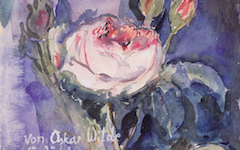Anselm Kiefer’s Everyone Stands Under His Own Dome of Heaven (1970)

Kiefer, Everyone Stands Under His Own Dome of Heaven (1970) Watercolor, gouache and graphite on joined paper. Metropolitan Museum of Art, New York.
Click image to enlarge.
Anselm Kiefer's Everyone Stands Under His Own Dome of Heaven is a contemporary example of how those following the Inner Tradition interpret heaven not as a location after death but a state of mind inside each of us. The blue dome even suggests Kiefer's eyeball on the surface of that mind; he has blue eyes.
Click next thumbnail to continue
This explains why Kiefer is under the dome. A German pacifist, he probably adopted a Nazi salute as a signature pose for several reasons, not least that in art opposites unite. Besides, it identifies him with Hitler just as earlier artists did with their own despised leaders.1 The raised arm and distinct legs also suggest a K for Kiefer, inverted2; while the arm could be the painter's brush-hand extended to the canvas.3 Lastly, he seems half-crucified, to convey perhaps how our minds are both deified and mortal.4
Click next thumbnail to continue
Kiefer's interest in spiritual alchemy is well-known. He never really wants to finish his works because they represent the eternal process in which "matter is not fixed but fluid, where at the heart of the material world is a dynamic atomic state that is constantly shifting and transforming.."5 Kiefer suggests that art's forms like nature's arise from chaos. Beauty (heavenly) is thus born from (evil) chaos just as consciousness of Wisdom is generally awakened through a hellish experience.
More Works by Kiefer
Notes:
1. Among others Edouard Manet gave his own features to the Emperor in The Execution of Emperor Maximillian (1867-8); Henri Daumier identified with King Louis-Philippe in Heave-Ho (1832) and Lower the Curtain, The Farce is Ended; and Picasso with the Fascist Franco in The Dream and Lie of Franco (1937).
2. See many other examples under the theme Letters in Art.
3. See introduction to the theme Poses of Painting.
4. See the theme Artist as Christ.
5. Richard Davey, “In the Beginning is the end and in the end is the beginning” in Anselm Kiefer (London: Royal Academy) 2014, p. 58
Original Publication Date on EPPH: 13 Mar 2015. © Simon Abrahams. Articles on this site are the copyright of Simon Abrahams. To use copyrighted material in print or other media for purposes beyond 'fair use', you must obtain permission from the copyright owner. Websites may link to this page without permission (please do) but may not reproduce the material on their own site without crediting Simon Abrahams and EPPH.


